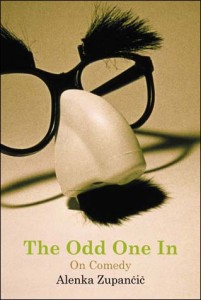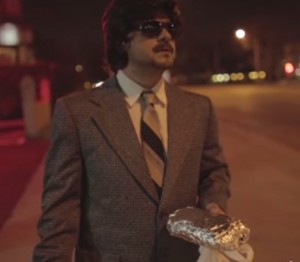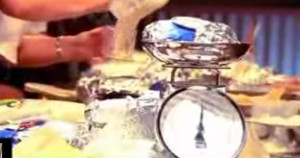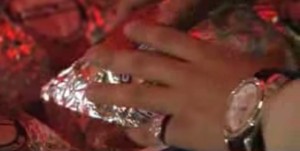On Friday, I will have the great privilege of presenting my paper “Undoing the Math: Chingo Bling, the ‘Not-All,’ and the Politics of Parody” at the 2014 meeting of the American Studies Association in Los Angeles, as part of the panel “Fugitive Preludes: Chicana/o Popular Music and the Neoliberal City.”
I worked out a lot of the ideas for my paper at this blog—and I want to thank the members of this community for helping me get my head straight on the complexities of Pedro “Chingo Bling” Herrerra III.
Today, I thought it would be interesting to include a section of the new paper that did not appear in any of the earlier blog posts. The essay I will deliver on Friday, as a whole, now focuses much more squarely on the Lacanian theme of the “not-all” and seeks to read Chingo Bling’s 2007 album They Can’t Deport Us All as a major philosophical statement in the literature of the “not-all.” To my mind, Chingo Bling does all the necessary conjugatory work in his music and videos; an interview from 2007 also helps to underline the key points:
I don’t feel like I’m the greatest rapper by no means, but I do feel like there is a lane for me and I do have something to say. Like our statement, “You Can’t Deport Us All.” You could wear that shirt in an airport, or you could wear it walking down the street and you’re gonna get a reaction from people. It’s gonna provoke thought. It’s gonna have people saying, “Oh, yes we can.” And, “Say it to my shotgun, boy.” Or “Man, that’s true.” You know, there’s really strength in numbers. There’s strength in unity and when we start to really think, “You know what, they probably really can’t.” Then we’re starting to call their bluff. It’s like, “Man you can’t deport us all. Dude, do you really want to deport us all? How many buses is it going to take and how logistically, who’s gonna build the fence and how much is it gonna cost and are we gonna be able to jump the fence again? How are you gonna go about rounding up everybody?” It’s not even possible. And the minute that we just snap out of that fear, you know, it’s a natural fear. Some people ain’t got no papers. If they just came from Guatemala and crossed three borders and jumped on five trains to get here, I’m not gonna belittle their fear [of being deported]. But what I’m saying is if we have a little unity, we can demand a little bit of respect because I feel like we’re second-class citizens. Even the ones that are citizens, like my parents––they were naturalized and everything. Shit, we still feel second-class like we’re in the back of the plane, no peanuts, and we’re just getting harassed.[1]
In the concluding section of the paper, I try work through the permutations of They Can’t Deport Us All, shifting the emphasis to reveal different nuances: They Can’t Deport Us All, They Can’t Deport Us All, They Can’t Deport Us All,
etc.The section I include here is the second in this series. It concerns “can’t-ness” and comedy, and I would love to hear about any thoughts, tangents, or criticisms that it elicits. Here is an excerpt.
They Can’t Deport Us All. “Can” or “can’t”––capacity, potentiality, standing-reserve––are the basic and foundational terms of power. It might not make much logical sense to de-link “can’t-ness” from the vicissitudes of “deportation,” but Chingo Bling is, among other things, a comedian, and comedy thrives on exactly such absurdities.
Recall the image of Chingo Bling’s father crossing the border via trampoline, or Bling’s line: “The border got the feds, but we the underground tunnels…” There is a gleeful anarchic comedy about all this—the sort of thing that would drive insane anyone with a rage for order (a Michelle Malkin, say). Controlling populations across borders, it turns out, is a difficult business, at least when trampolines are lying around.
Seeking to identify the essence of comic subjectivity, the philosopher Alenka Zupancic argues that comedy is not, fundamentally, about the ontological nature of the comedian or clown; nor is it simply the genre that features “comedic characters” (the low-born, bumbling idiots, talking animals, etc.) Rather, it is an “incessant and irresistible, all consuming movement”: “stumbling, interruptions, punctuations, discontinuities…”[2] Zupancic comes very close, that is, to identifying comedy with a constitutive “can’t-ness”––a “can’t-ness” that overlaps substantially with the idea of the “not-all.”
Zupancic’s is a “can’t-ian” theory of comedy that rests on a Hegelian premise: that comedy is “the negative power through which and in which the gods vanish.” Turning to Lacan, Zupancic describes comedy’s “can’t-ness” as an escape from finitude––the knowledge of limits and limitations of living human beings. The “not-all” does not fall under the sign of finitude (which governs the male side of the “graphs of sexuation” governed by the “logic of exception”). The theme of conservative comedies: aren’t we all loveably failed, flawed, incomplete. Here, we might think of recent comic figures in carceral-state melodramas like Breaking Bad––the lunkheaded Hank Schrader––and The Wire––the idiot beat cops Herc and Carver. In contrast, we might see the truly subversive comic elements in these shows as objects: the glittering sheets of blue crystal meth in Breaking Bad
or “the wire” in The Wire, which relentlessly mock finitude itself.[3]
Zupancic observes that neoliberal common sense often takes the form of a “redoubling of description by prescription”: a passage from the recognition of the limited and divided character of human existence to an affirmative demand for limitedness and dividedness (“don’t sweat the small stuff”). Comedy, in its “can’t-ian” dimension rejects this identification with finitude, and seeks an ethical orientation from the Real—the materiality of the world, the “way things work” outside of language and thought.
The “can’t” of comedy speaks, then, to finitude’s own finitude. Comic objects are often those that exemplify a “failed finitude.” Chingo Bling’s aesthetic universe overflows with these sorts of objects: the ostrich-skin Nike boot, the iced-out pendant designed around the “Caution” immigrant crossing warning sign.
Perhaps the best example is the way in which Herrerra replaces the paraphernalia of drug dealing, endlessly eulogized in commercial hip-hop, with the objects of the taco and tamale trade. What is most brilliant about these substitutions and parodic repetitions is the pleasure Bling takes in revealing that the secret ingredient of his underground empire is “masa and flour”—where we expect something illicit and titillating, we find exactly what is supposed to be there. When the tinfoil wrappers are peeled back, Bling’s “stacks” are revealed to be made up of precisely what he advertises: tamales. The comedy lies in the object’s failure to fail (to not be what it looks like).
Zupancic’s “can’t-ian” theory of comedy also helps to explain a consistent (yet chronically under-studied) feature of comedy: The comic universe is, as a rule, the universe of the indestructible (as in cartoons). This indestructibility is a crucial dimension of Chingo Bling’s project—which, after all, takes on a variety of painful and terrifying realities. Consider the image from They Can’t Deport Us All’s album art: a cartoon Chingo Bling hopping a razor-wire fence, trusty rooster Cleto by his side, state trooper shaking his fist and throwing down his hat in Bling’s dust.
Here, Herrerra paints a world in which, as Zupancic writes: “Regardless of all accidents and catastrophes (physical as well as psychic or emotional) that befall comic characters, they always rise from the chaos perfectly intact, and relentlessly go on pursuing their goals, chasing their dreams, or simply being themselves.”
In comedy, which is supposed to be a realistic form (it undermines every fantasy of mastery and revels in the humiliations of the Grobian or Rabelasian body), then, we also find a resolutely surreal or fantastic texture.[4] This, it seems to me, resonates powerfully with the “not-all,” and speaks to the power of They Can’t Deport Us All qua radical slogan. As Zupancic puts it, in comedy––ostensibly a “genre of the concrete”––the concrete does not seem really to get to people.
Notes
[1] Matt Sonzala, “Chingo Bling,” Ozone, SXSW special issue, 2007, 23-26.
[2] Alenka Zupancic, The Odd One In: On Comedy. Cambridge, Mass: MIT Press, 2008.
[3] Another truly comic object in The Wire is the high-tech video camera tennis ball purchased by the (conservative) comic duo of Herc and Carver, and which serves as an allegorical illustration of the show’s most radical themes.
[4] See Anca Parvulescu, Laughter: Notes on a Passion. Cambridge, Mass: MIT Press, 2010.





0